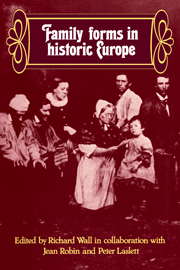Book contents
- Frontmatter
- Contents
- List of contributors
- Preface
- 1 Introduction
- 2 Two kinds of pre-industrial household formation system
- 3 ‘A large family: the peasant's greatest wealth’: serf households in Mishino, Russia, 1814–1858
- 4 The peasant family as an economic unit in the Polish feudal economy of the eighteenth century
- 5 The familial contexts of early childhood in Baltic serf society
- 6 Estonian households in the seventeenth and eighteenth centuries
- 7 Family and familia in early-medieval Bavaria
- 8 The property and kin relationships of retired farmers in northern and central Europe
- 9 Pre-industrial household structure in Hungary
- 10 The reconstruction of the family life course: theoretical problems and empirical results
- 11 The changing household: Austrian household structure from the seventeenth to the early twentieth century
- 12 Does owning real property influence the form of the household? An example from rural West Flanders
- 13 The evolving household: the case of Lampernisse, West Flanders
- 14 The composition of households in a population of 6 men to 10 women: south-east Bruges in 1814
- 15 The importance of women in an urban environment: the example of the Rheims household at the beginning of the Industrial Revolution
- 16 The household: demographic and economic change in England, 1650–1970
- 17 Family and household as work group and kin group: areas of traditional Europe compared
- References
- Index
16 - The household: demographic and economic change in England, 1650–1970
Published online by Cambridge University Press: 05 November 2011
- Frontmatter
- Contents
- List of contributors
- Preface
- 1 Introduction
- 2 Two kinds of pre-industrial household formation system
- 3 ‘A large family: the peasant's greatest wealth’: serf households in Mishino, Russia, 1814–1858
- 4 The peasant family as an economic unit in the Polish feudal economy of the eighteenth century
- 5 The familial contexts of early childhood in Baltic serf society
- 6 Estonian households in the seventeenth and eighteenth centuries
- 7 Family and familia in early-medieval Bavaria
- 8 The property and kin relationships of retired farmers in northern and central Europe
- 9 Pre-industrial household structure in Hungary
- 10 The reconstruction of the family life course: theoretical problems and empirical results
- 11 The changing household: Austrian household structure from the seventeenth to the early twentieth century
- 12 Does owning real property influence the form of the household? An example from rural West Flanders
- 13 The evolving household: the case of Lampernisse, West Flanders
- 14 The composition of households in a population of 6 men to 10 women: south-east Bruges in 1814
- 15 The importance of women in an urban environment: the example of the Rheims household at the beginning of the Industrial Revolution
- 16 The household: demographic and economic change in England, 1650–1970
- 17 Family and household as work group and kin group: areas of traditional Europe compared
- References
- Index
Summary
The basic structure of English households in the pre-industrial era is now well known. Households were small. The majority contained fewer than five persons, and membership was customarily confined to parents and their unmarried children. If the family was sufficiently wealthy, or involved in farming or trade, then the household might well contain servants, but there were remarkably few complex households containing grandparents, parents, and grandchildren. Untimely death in the older generation and average age at marriage in the mid- to late 20s for both sexes naturally curtailed the number of three-generational households that it was possible to form. But the number that were formed never came anywhere near the potential number.2 It was not because children married late while their parents died early that few households spanned three generations, but because the vast majority of children who had not already left the parental home to become servants in the households of others would establish separate households on marrying.
The implication of the link between marriage and the formation of a household is that English households must have varied in structure over time. Nationally, the crude marriage rate fell steadily to reach a low point in the late seventeenth century, from which it rose to a high plateau between 1771 and 1796 before falling again.
- Type
- Chapter
- Information
- Family Forms in Historic Europe , pp. 493 - 512Publisher: Cambridge University PressPrint publication year: 1983
- 9
- Cited by



